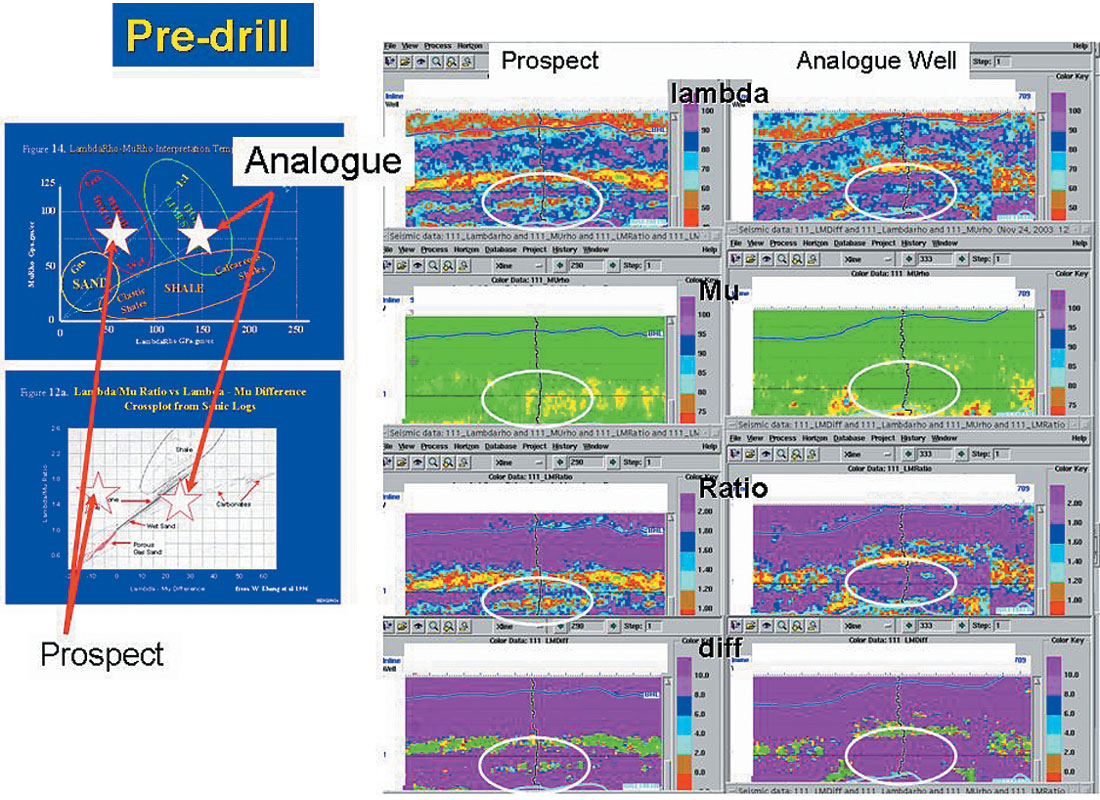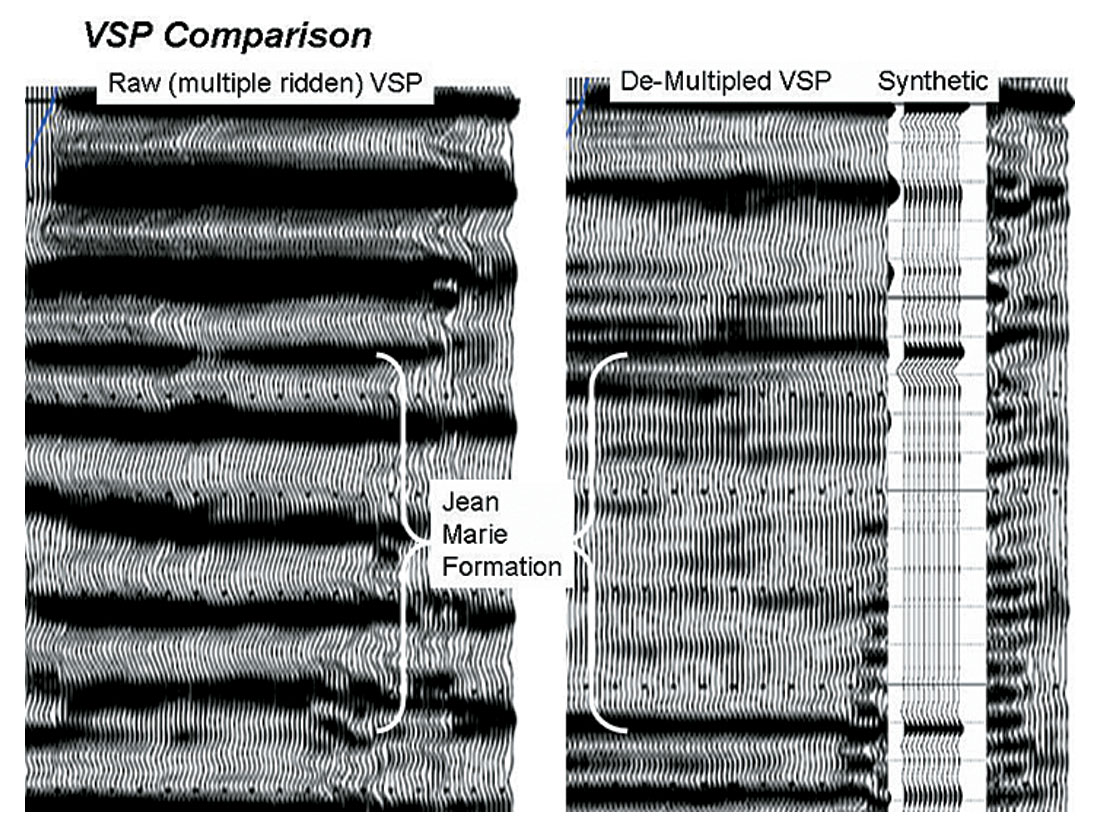Summary
Seismic Attributes have been one of the primary identification/ evaluation methods throughout the Western Canadian Sedimentary Basin and stratigraphic column, first on 2D data and now predominantly on 3D seismic. Seismic data have limitations and ambiguities that have been stretched and in some cases blatantly abused. Seismic data were first used for structure and growth interpretation and mapping. Later techniques were applied to identify lithology, and porosity from seismic data which helped to identify reservoirs. In recent years AVO and related techniques have been used to simultaneously predict lithology, identify reservoir and in some cases fluid content. Some old theories and methods will be used here along with new data and techniques to look at some of the pitfalls and false friends that can lead us to misinterpret our data and potential anomalies. The integration of VSP, petrophysical logs and detailed investigation into multiples, imaging and attenuation effects will lead to a better interpretation and higher success rates in the search for conventional and unconventional reservoirs.
Introduction
Seismic data have been a very powerful tool used in the exploration of reservoirs throughout the world and no less so in the Western Canadian Sedimentary Basin. Seismic 2D data criss-cross our countryside and now 3D data is commonplace throughout the exploration/production process. This does not come without a physical cost, a level of un-earned optimism, and some complacency. In post-morteming disappointing well results and integrating the learning’s from them, some surprises and old ‘foes’ have shown up and will have to be overcome in the future.
Seismic Attributes have been used for decades to identify and map the extent of reservoirs throughout the Western Canadian Sedimentary Basin in most of the producing zones. As these targets get more subtle and more “unconventional” the contamination from multiples and the distortion from attenuation have become an increasingly more important problem to solve. The search for deeper, thinner lower porosity reservoirs has made these issues critical. The move to “unconventional” has also lead us to exploring for reservoirs in seismic transparent zones that we previously thought of as seals and traps, so that unraveling of their reservoir properties has become important now. Additionally the high drilling and completion costs, along with lower initial rates, make the use of seismic and the highgrading of sweetspots economically critical.
Case Study to highlight problem
To highlight the problems and converge on a solution, a dolomite reservoir case history will be presented. Li et al. Rafavich et al. and Goodway et al. eloquently demonstrated the successful use of seismic to identify subtle conventional reservoirs and methods for evaluation and differentiate them from their surrounding seals and regional rock. This can be used for both conventional and unconventional reservoir delineation when the “reservoir” is known. Several papers have recognized the need for detailed, non-distortive, high frequency and phase/amplitude controlled seismic processing. In agreement with those, this paper will concentrate on seismic phenomena that can distort and degrade these results, and lead to false anomalies.
The seismic data used in this area were processed with a controlled amplitude/phase methodology, that included Pre- Stack Time Migration, 2 passes of detailed geologic consistent velocities, and 2 passes of state-of-the-art de-multiple. The data were then analyzed in an AVO workflow that included IP and IS inversions and LambdaMuRho transform attributes.
Figure 1 shows the comparison of the LMR results over a known dry well that encountered only regional limestone on the right with a the attributes of the prospect on the left. The low Lambda and Mu values as well as the low Lambda/Mu ratio, lead to the conclusion that this prospect has a very high chance of encountering dolomite with porosity successfully and indications of being gas filled.

Post drill analysis for the well shows the target rock is a tight limestone with no indication of dolomite or porosity. The petrophysical logs from the well are excellent quality with very few washouts, but do not accurately tie the surface seismic section. Why?
VSP data were collected in the well, and processed to understand and reduce the misties between the wireline logs and the surface seismic. Figure 2 shows the detailed results of the VSP and the surface seismic.
In comparing the sections in Figure 2 we see that the zero offset VSP does not tie the surface seismic accurately. There appears to be strong variations in amplitude in the zone of interest as well as an apparent phase difference. This dataset was processed with great care to preserve and control the phase and amplitude. The final phase matching to known geologic tops of predictable acoustic properties was carried out throughout the section but did not result in a significant improvement With greater investigation the inside stack appears to tie better from an amplitude perspective, the phase still appears incorrect but to a much lesser extent. Or is it? A well tie shows that the phase will have to be rotated between 45 and 90 degrees to achieve the highest correlation. This is in direct contradiction with the pre-drill shallow phase matching and exhibits a strong time varying effect. The easiest explanation for this behavior is attenuation or ‘Q’.

The concept of attenuation ‘Q’ has been around for years and numerous papers have been written on the time varying phase effects of shales and anisotropic rock on seismic waves and apparent phase distortion at reflectors. Rio et al. demonstrated the effects of laminations of varying thickness to wavelength ratios, on the phase and amplitude of the propagated wave. Tonn, compared different methods and showed the similarity and diff e rences of the methods overall correction of the seismic data. A modeled theoretical effect using a constant high Q (non-attenuative) and a variable Q on the amplitude and more importantly the phase of the data shows there is little effect on shallow reflections where the amplitude and the phase are virtually equal and the phase is unaffected. At deeper reflections after pro pagating through the laminated anisotropic shale section the amplitude and the phase are distorted quite drastically.
To compound this effect with additional contamination by higher order, short period multiples, with little residual moveout, could, and have lead to erroneous interpretations. The phase shifted multiple ridden zone can take on the appearance of perspective reservoir with porosity and desired fluid fill.
Application to All reservoirs
The case study outlined a subtle problem that most likely exists in most of the seismic data that we use to identify and develop reservoirs. The problem compounds when we are exploring for and developing more low impedance “unconventional” reservoirs. Figure 3. shows a VSP section throught the Jean Marie formation before and after VSP de-multiple. This highlights all possible multiple contamination and what must be overcome before using the seismic data. Great skill is required in removing these multiples while preserving the real subtle reflectivity that represents an optimum drilling location. Several methods have been tried and will be presented that attempt to remove multiples and correct for attenuation both pre and post stack. Ultimately these methodologies are interpreter driven and carry a very heavy caveat emptor.

Conclusions
Seismic data can be degraded and ridden with contamination that can lead to in-correct interpretations. Detailed analysis, investigation of potential seismic contamination as well as full integration of a robust and sound geologic model can mitigate some of these effects. The correction for these distortions is quite straightforward and can be carried out in most processing centers but must be understood and quantified through VSP data and models. De-multiple is critical to the preservation of the geologic information within our seismic data and must be applied in a logical and informed manner to remove the multiple without affecting the primary amplitude or phase. Attenuation can be determined from wireline logs and VSP data, or derived from the seismic data only, and again must be applied with care and quality control.
This paper has demonstrated the effects of these potential distortive processes on prospecting for conventional and unconventional reservoirs in the Western Canadian Sedimentary Basin. The understanding and proper corrections for these effects, and interpretation with them in mind can help to mitigate risk in these subtle reservoirs but the caveat must be stated: the missuse or abuse of these corrections, or the generic application of these results can and will be disastrous.

Acknowledgements
We would like to thank Dominion Canada, and Anadarko Canada Corporation for permission to publish this paper. We would like to acknowledge and thank Schlumberger for help in the analysis of the VSP data, and permission to use their seismic data. We would like to thank ARCIS Corporation and PULSE Data Inc. for permission to use their data. We would also like to thank Rick Kuzminski and Rob Duthie, VSFusion for there VSP help and guidance.










Join the Conversation
Interested in starting, or contributing to a conversation about an article or issue of the RECORDER? Join our CSEG LinkedIn Group.
Share This Article